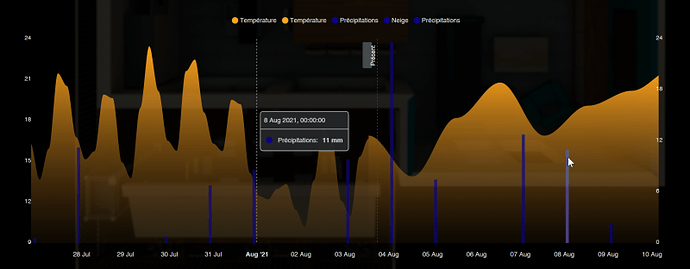how do I set the time period? e.g in grafana you can easily choose the time period, I couldn’t find any mention of it in the apex-chart documnetion.
I’m having this issue:

It’s sunday (dom) and bar is not where it should be (or maybe is the lavel the one wrong). Another thing is why xaxis don’t take the whole available width.
Card config:
type: custom:apexcharts-card
header:
show: true
title: Consumo Energía Semanal
show_states: true
colorize_states: true
apex_config:
chart:
height: 200px
yaxis:
min: 0
tickAmount: 4
xaxis:
type: datetime
labels:
datetimeFormatter:
day: ddd
graph_span: 1week
span:
start: week
series:
- entity: sensor.energy_daily
name: Hoy
type: column
float_precision: 2
group_by:
func: max
duration: 1d
- entity: sensor.energy_weekly
name: Total semana
float_precision: 2
show:
in_chart: false
Edit:
Also values not calculated correctly.
I’m displaying a utility meter in bar chart with group_by day and func max. Trying with last instead of max, but it gives worse results


Card config:
type: custom:apexcharts-card
header:
show: true
title: Consumo Energía Semanal
show_states: true
colorize_states: true
apex_config:
chart:
height: 200px
xaxis:
labels:
format: ddd
hideOverlappingLabels: false
graph_span: 1week
series:
- entity: sensor.energy_daily
name: Hoy
type: column
float_precision: 2
group_by:
func: max
duration: 1d
Hi! I love this graph card, there is only one thing that I am not able to do:
I have a column chart with only one series. I’ve defined a color_threshold and also, defined the colorized_states: true option.
Is there any chance to show the state with the same color than the current value of the serie defined in color_threshold?
For example: if the curren column is red, show the title in red.
Or at least being able to define a javascript function to calculate the color of the title?
Thanks!
Hi Enrico,
im italian too.
I am struggling with apex chert, i would like to have a graph (not bargraph but curve) showing solar production, consumed and sold energy.
Do you have some suggestions or yaml to share?
Thanks!!!
So… I’ve figured out enough about data_generator to solve my problem. Thanks again to @RomRider for the card. For those other newbies interested, I found two ways to set the state of a sensor to test / build from the basic data_generator examples (the weather.home & tides)
- Use the Developer Tools > States tab to manually set the state & attributes of a sensor
- Use the ‘Set State’ python script
It is a hack, but by using the python script in an automation that runs on startup, I’m able to load my rolled up monthly history of a few key variables into HA, so I can chart it along with the live 7 day data in my HA database. Here is a picture of some of the graphs produced.
looking for some guidance, creating my 2nd effort today to plot 2 y-axis’s without success so far…
first I trired mini-graph-card, but because I couldn’t get the secondary y-axis to be set correctly, here’s my first go at it using the apexcharts:
- type: custom:apexcharts-card
apex_config:
yaxis:
- id: sun
show: true
title: Sun
min: 0
max: 6000
- id: cloud
show: false
title: Cloud
min: 0
max: 100
span:
start: day
header:
show: true
title: Sun - Cloud
series:
- yaxis_id: sun
entity: sensor.zp_actuele_opbrengst
type: area
fill_raw: last
extend_to_end: false
color: gold
name: Sun
- yaxis_id: cloud
entity: sensor.weatherbit_cloud_coverage
type: line
# fill_raw: last
# extend_to_end: false
color: grey
name: Cloud
won’t show me my clouds, or even the scale for that matter:
deselecting the Sun renders an empty graph (though the legend shows the clouds to be indentified correctly:
please have a look where I am troubling myself? thanks!
edit
duh, of course I have to set it to show: true… and opposite: true
still seems off … while I cant get rid of the decimals, using
apex_config:
decimalsInFloat: 0
on either y axis’s or generic
update
solved too:
apex_config:
yaxis:
- id: sun
show: true
# title: Sun
min: 0
max: 6000
decimalsInFloat: 0
- id: cloud
opposite: true
show: true
# title: Cloud
min: 0
max: 100
decimalsInFloat: 0
noob…
It’s possible to have the forecast for the rain ? with weather.openweathermap ??
Can you show your code please thanks
Hello Every Body
First thanks for this !!! I would like to show in a donut the energy use yesterday or for the last month i try this code but in the value in receive le last value of yesterday (exemple 411 kwh) not the value for only yesterday (exemple 12 kWh)
type: custom:apexcharts-card
graph_span: 24h
cache: true
span:
start: day
apex_config:
chart:
height: 400px
plotOptions:
pie:
donut:
total:
show: true
showAlways: true
header:
show: true
title: Utilisatation Du Réseau
chart_type: donut
series:
- entity: sensor.bureau_conso
offset: '-1d'
- entity: sensor.chaud_conso
offset: '-1d'
- entity: sensor.lavev_conso
offset: '-1d'
- entity: sensor.mal_conso
offset: '-1d'
- entity: sensor.nas_conso
offset: '-1d'
- entity: sensor.sdj_conso
offset: '-1d'
- entity: sensor.tv_conso
offset: '-1d'
What a great solution for HA!
I’m measuring the amount of rail, and my intention was to ensure that it was from “0.0 to 23.59”, but it seems to be a bit different
Can anyone help me find a way for ensuring that my graph’s is one full day?
Is there a way with ApexCharts to shade under a curve for portions only when my air conditioning is on? The stock history graph card can do this (as seen in picture). Thanks.
Would love if you can share your code for this? Have just started monitoring daily solar costs and savings but would love to be able to graph historical costs and consumption like you have 
Hi! I’ve discovered an issue where the tooltip is cut off. I’m wondering if this is some sort of a freak occasion, as it seems quite a big flaw in the card. Or are my charts and cards just too small and the tooltip fits into the card for everybody else?
I tried debugging it and trying to understand the box model and overflows involved, and found out that the <ha-card> element has overflow: hidden defined on it.
I’ve made a pull request and hopefully, it’ll get fixed soon, unless I misunderstood something and am just using it wrong.
On an unrelated topic: is it possible to have dynamic values in the configuration? E,g, I would like to hide numbers in the header if the value is 0, but this doesn’t get parsed:
- entity: sensor.rtorrent_down_speed
show:
in_header: '{{ float(states.sensor.rtorrent_down_speed.state) > 0 }}'
Hi,
Don’t know if you managed it, I’ve been struggling with the same question. Here is the part of the code that gets rid of the borders on the side and the bottom:
apex_config:
grid:
margin:
left: 0
right: 0
chart:
offsetY: 15
parentHeightOffset: 0
Ok, so I’ve set myself a lofty goal here, but I’m reaching some limitations that I’ve been unable to get around these past few days. Any insight would be greatly appreciated.
What I want to achieve: a weather chart mapping past temperatures, temperature forecast, past precipitation (rain + snow) and precipitation forecast. I would like to show the past 7 days, temperatures are areas (same color for past and future) and precipitation are columns (stacked for rain + snow) placed on the relevant day’s tick. The card itself is placed on a picture-elements card, should take up about the whole width and about 40% of the height of said picture-elements card.
The following are my current hurdles:
-
There’s an overlap in data. My forecast data provided via data-generator includes the present day. Currently using OWM with onecall daily API. That leads me to have two columns on the same day as well as an area overlap for temperatures. Overlap in temperatures:
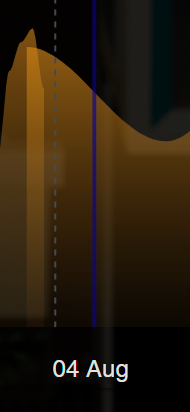
I’m no JS wiz, but I’m guessing I’d need to fiddle with the data-generator code to avoid these overlaps? -
If I don’t set the columns to a ridiculous width (e.g. 600%) via
apex-config, they are way to thin to my taste. However, setting the columns this wide messes with their placement with regard to the x-axis ticks and displaces the background behind the “now” flag. Even is the case when column width is set to 100%.

How do I get the columns wider without messing up the entire layout? And I’d like the column to be set either in centered between ticks - noon - or on the ticks - midnight. Currently, they’re in between but not centered. -
Somehow, the tooltips for the forecast precipitation show up in the past. See:
Any Idea why that is? My data-generator code perhaps?
It’s still a work in progress, here’s the code for the card:
- type: 'custom:apexcharts-card'
graph_span: 14d
span:
start: day
offset: -7d
now:
show: true
label: 'Présent'
yaxis:
- id: temp
show: true
apex_config:
forceNiceScale: true
tickAmount: 5
decimalsInFloat: 0
- id: rain
show: true
opposite: true
apex_config:
forceNiceScale: true
tickAmount: 5
decimalsInFloat: 0
apex_config:
dataLabels:
enabled: false
chart:
width: '100%'
height: 100%
legend:
position: top
grid:
show: false
padding:
left: 0
right: 0
stroke:
colors: ['#ffa31a', '#03a8f4', 'none']
fill:
type: ['gradient', 'gradient', 'solid', 'solid', 'solid']
gradient:
type: 'vertical'
shadeIntensity: 0.5
inverseColors: false
opacityFrom: 1
opacityTo: 0.3
stops:
- 0
opacity: 0.65
plotOptions:
area:
fillTo: origin
bar:
columnWidth: 100%
stacked: true
xaxis:
axisBorder:
show: false
axisTicks:
show: false
tooltip:
enabled: false
tickPlacement: 'on'
series:
- entity: weather.openweathermap
type: area
name: 'Température'
unit: °C
attribute: temperature
stroke_width: 0
yaxis_id: temp
color: '#ffa31a'
fill_raw: last
show:
legend_value: false
group_by:
func: avg
duration: 2h
extend_to_end: false
- entity: weather.openweathermap
type: area
stroke_width: 0
yaxis_id: temp
color: '#ffa31a'
name: 'Température'
unit: °C
extend_to_end: false
fill_raw: last
show:
legend_value: false
data_generator: |
return entity.attributes.forecast.map((entry) => {
return [new Date(entry.datetime).getTime(), entry.temperature];
});
- entity: sensor.openweathermap_rain
type: column
yaxis_id: rain
name: 'Précipitations'
unit: mm
color: '#0b0385'
fill_raw: last
show:
legend_value: false
group_by:
func: sum
duration: 1d
- entity: sensor.openweathermap_snow
type: column
yaxis_id: rain
name: 'Neige'
unit: mm
color: '#0b0385'
fill_raw: last
show:
legend_value: false
group_by:
func: sum
duration: 1d
- entity: weather.openweathermap
type: column
yaxis_id: rain
color: '#0b0385'
name: 'Précipitations'
unit: mm
extend_to_end: false
fill_raw: last
show:
legend_value: false
data_generator: |
return entity.attributes.forecast.map((entry) => {
return [new Date(entry.datetime).setHours(0, 0, 0, 0), entry.precipitation];
});
card_mod:
style: |
:host {
left: 50%;
top: 75%;
width: 90%;
height: 40%;
}
ha-card {
background: none !important;
height: 100%;
}
.wrapper.with-header {
height: 100%;
}
I am trying to track the number of times the garage door has been opened in a day.
This is the screenshot of the history of the entity.

The last value for Aug 3 and 4 is 7 and 3 respectively.
I am trying to plot the last value of the entity for a day in a chart.
type: custom:apexcharts-card
header:
show: true
show_states: true
yaxis:
- min: ~2
apex_config:
decimalsInFloat: 0
forceNiceScale: true
apex_config:
chart:
height: 200px
graph_span: 7d
color_list:
- tomato
series:
- entity: sensor.garage_door_daily_count
type: column
group_by:
func: last
duration: 1d
The chart appears as below, where the value is 3 for both the days.

If I change the group_by function to max, the chart appears as below. The values seem to be flipped around for the 2 dates.

Any help with getting the chart to show the right values on the right days?
Hi,
I wonder if anyone can help. I have an entity with a bunch of attributes that’s retrieved from my electricity providor. Its an array which contains my consumption every half hour. Example output is below from the attribute.
Is there any way I can graph this using ApexCharts? I have tried and can’t work out what I would need to do, can I use both the consumption as the y axis and the interval start/end as the x axis?
Thank you in advance!
Craig
Results
- consumption: 0.097 interval_start: ‘2021-08-04T00:00:00+01:00’ interval_end: ‘2021-08-04T00:30:00+01:00’ - consumption: 0.08 interval_start: ‘2021-08-03T23:30:00+01:00’ interval_end: ‘2021-08-04T00:00:00+01:00’ - consumption: 0.139 interval_start: ‘2021-08-03T23:00:00+01:00’ interval_end: ‘2021-08-03T23:30:00+01:00’ - consumption: 0.176 interval_start: ‘2021-08-03T22:30:00+01:00’ interval_end: ‘2021-08-03T23:00:00+01:00’ - consumption: 0.167
I have a goal of displaying external data so that I don’t need to include my weather data into homeassistant (and can have a long term graph) and today we succeeded in doing so with a custom web server. But I do get interesting results displayed.

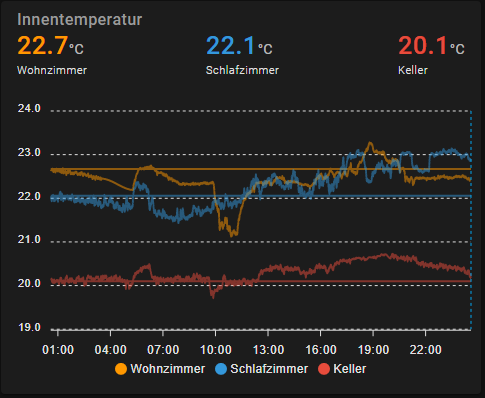
Using (almost) the same data via mqtt sensor works like it should
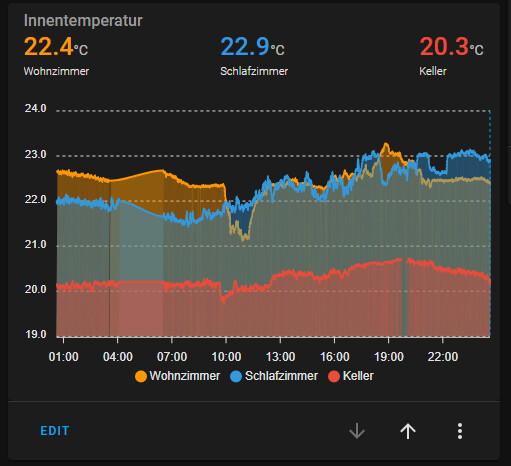
This is the complete code of the data generator card:
type: custom:apexcharts-card
graph_span: 1d
hours_12: false
header:
show: true
title: Innentemperatur
show_states: true
colorize_states: true
standard_format: false
now:
show: true
all_series_config:
type: area
stroke_width: 2
opacity: 0.5
unit: °C
show:
legend_value: false
series:
- entity: sensor.time
name: Wohnzimmer
data_generator: |
function makeRequest(method, url) {
return new Promise(function (resolve, reject) {
let xhr = new XMLHttpRequest();
xhr.open(method, url);
xhr.onload = function () {
if (this.status >= 200 && this.status < 300) {
resolve(xhr.response);
} else {
reject({
status: this.status,
statusText: xhr.statusText
});
}
};
xhr.onerror = function () {
reject({
status: this.status,
statusText: xhr.statusText
});
};
xhr.send();
});
}
const request = async () => {
var http = new XMLHttpRequest();
var response = await makeRequest('GET', 'https://kuroi1992.dyndns.pro/test?type=temperature&location=inside&name=wohnzimmer&time=24h');
console.debug(response);
var json = JSON.parse(response);
console.debug(json);
return json.map(x => {
return [x['time'], x['value']];
});
}
return request();
- entity: sensor.time
name: Schlafzimmer
data_generator: |
function makeRequest(method, url) {
return new Promise(function (resolve, reject) {
let xhr = new XMLHttpRequest();
xhr.open(method, url);
xhr.onload = function () {
if (this.status >= 200 && this.status < 300) {
resolve(xhr.response);
} else {
reject({
status: this.status,
statusText: xhr.statusText
});
}
};
xhr.onerror = function () {
reject({
status: this.status,
statusText: xhr.statusText
});
};
xhr.send();
});
}
const request = async () => {
var http = new XMLHttpRequest();
var response = await makeRequest('GET', 'https://kuroi1992.dyndns.pro/test?type=temperature&location=inside&name=schlafzimmer&time=24h');
console.debug(response);
var json = JSON.parse(response);
console.debug(json);
return json.map(x => {
return [x['time'], x['value']];
});
}
return request();
- entity: sensor.time
name: Keller
data_generator: |
function makeRequest(method, url) {
return new Promise(function (resolve, reject) {
let xhr = new XMLHttpRequest();
xhr.open(method, url);
xhr.onload = function () {
if (this.status >= 200 && this.status < 300) {
resolve(xhr.response);
} else {
reject({
status: this.status,
statusText: xhr.statusText
});
}
};
xhr.onerror = function () {
reject({
status: this.status,
statusText: xhr.statusText
});
};
xhr.send();
});
}
const request = async () => {
var http = new XMLHttpRequest();
var response = await makeRequest('GET', 'https://kuroi1992.dyndns.pro/test?type=temperature&location=inside&name=keller&time=24h');
console.debug(response);
var json = JSON.parse(response);
console.debug(json);
return json.map(x => {
return [x['time'], x['value']];
});
}
return request();
apex_config:
markers:
hover:
size: 5
Before anyone suggests it, yes, the same problem happens even if I use the sensors corresponding to the temperature sensor, I just replaced them with sensor.time because in the long run I want to run completely via data generator and I needed to test if it works with any random sensor.
I have another graph using the same code and web backend with similar temperatures and on thet one it displays correctly so far.
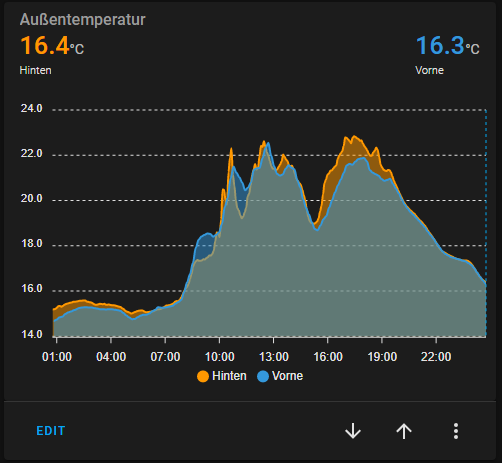
The webserver used for testing is not online most of the time, so if anyone tries to test the example ot, it most likely won’t work.
Anyone got any idea how to force the curves to display correctly? I did try to manually set a minimum for the yaxis, but that only moved the yaxis, but still didn’t render the curves down to the axis.
I just want to say that I absolutely love this card. I struggled a lot trying to get the mini-graph-card to do what I wanted and ended up only partially succeeding, while it only took about 30mins to get this working 100%. Between this and the custom button card, my dashboard is about 90% RomRider-powered  .
.








